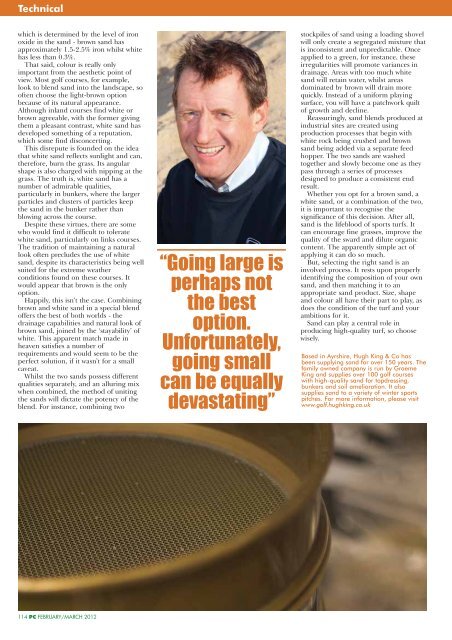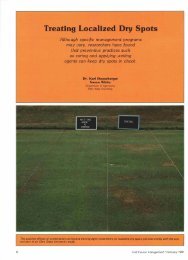these Open Championship Clubs choose to relief grind - Pitchcare
these Open Championship Clubs choose to relief grind - Pitchcare
these Open Championship Clubs choose to relief grind - Pitchcare
You also want an ePaper? Increase the reach of your titles
YUMPU automatically turns print PDFs into web optimized ePapers that Google loves.
Technical<br />
which is determined by the level of iron<br />
oxide in the sand - brown sand has<br />
approximately 1.5-2.5% iron whilst white<br />
has less than 0.3%.<br />
That said, colour is really only<br />
important from the aesthetic point of<br />
view. Most golf courses, for example,<br />
look <strong>to</strong> blend sand in<strong>to</strong> the landscape, so<br />
often <strong>choose</strong> the light-brown option<br />
because of its natural appearance.<br />
Although inland courses find white or<br />
brown agreeable, with the former giving<br />
them a pleasant contrast, white sand has<br />
developed something of a reputation,<br />
which some find disconcerting.<br />
This disrepute is founded on the idea<br />
that white sand reflects sunlight and can,<br />
therefore, burn the grass. Its angular<br />
shape is also charged with nipping at the<br />
grass. The truth is, white sand has a<br />
number of admirable qualities,<br />
particularly in bunkers, where the larger<br />
particles and clusters of particles keep<br />
the sand in the bunker rather than<br />
blowing across the course.<br />
Despite <strong>these</strong> virtues, there are some<br />
who would find it difficult <strong>to</strong> <strong>to</strong>lerate<br />
white sand, particularly on links courses.<br />
The tradition of maintaining a natural<br />
look often precludes the use of white<br />
sand, despite its characteristics being well<br />
suited for the extreme weather<br />
conditions found on <strong>these</strong> courses. It<br />
would appear that brown is the only<br />
option.<br />
Happily, this isn’t the case. Combining<br />
brown and white sand in a special blend<br />
offers the best of both worlds - the<br />
drainage capabilities and natural look of<br />
brown sand, joined by the ‘stayability’ of<br />
white. This apparent match made in<br />
heaven satisfies a number of<br />
requirements and would seem <strong>to</strong> be the<br />
perfect solution, if it wasn’t for a small<br />
caveat.<br />
Whilst the two sands possess different<br />
qualities separately, and an alluring mix<br />
when combined, the method of uniting<br />
the sands will dictate the potency of the<br />
blend. For instance, combining two<br />
114 PC FEBRUARY/MARCH 2012<br />
“Going large is<br />
perhaps not<br />
the best<br />
option.<br />
Unfortunately,<br />
going small<br />
can be equally<br />
devastating”<br />
s<strong>to</strong>ckpiles of sand using a loading shovel<br />
will only create a segregated mixture that<br />
is inconsistent and unpredictable. Once<br />
applied <strong>to</strong> a green, for instance, <strong>these</strong><br />
irregularities will promote variances in<br />
drainage. Areas with <strong>to</strong>o much white<br />
sand will retain water, whilst areas<br />
dominated by brown will drain more<br />
quickly. Instead of a uniform playing<br />
surface, you will have a patchwork quilt<br />
of growth and decline.<br />
Reassuringly, sand blends produced at<br />
industrial sites are created using<br />
production processes that begin with<br />
white rock being crushed and brown<br />
sand being added via a separate feed<br />
hopper. The two sands are washed<br />
<strong>to</strong>gether and slowly become one as they<br />
pass through a series of processes<br />
designed <strong>to</strong> produce a consistent end<br />
result.<br />
Whether you opt for a brown sand, a<br />
white sand, or a combination of the two,<br />
it is important <strong>to</strong> recognise the<br />
significance of this decision. After all,<br />
sand is the lifeblood of sports turfs. It<br />
can encourage fine grasses, improve the<br />
quality of the sward and dilute organic<br />
content. The apparently simple act of<br />
applying it can do so much.<br />
But, selecting the right sand is an<br />
involved process. It rests upon properly<br />
identifying the composition of your own<br />
sand, and then matching it <strong>to</strong> an<br />
appropriate sand product. Size, shape<br />
and colour all have their part <strong>to</strong> play, as<br />
does the condition of the turf and your<br />
ambitions for it.<br />
Sand can play a central role in<br />
producing high-quality turf, so <strong>choose</strong><br />
wisely.<br />
Based in Ayrshire, Hugh King & Co has<br />
been supplying sand for over 150 years. The<br />
family owned company is run by Graeme<br />
King and supplies over 100 golf courses<br />
with high-quality sand for <strong>to</strong>pdressing,<br />
bunkers and soil amelioration. It also<br />
supplies sand <strong>to</strong> a variety of winter sports<br />
pitches. For more information, please visit<br />
www.golf.hughking.co.uk

















